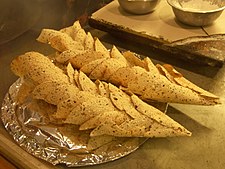


Fire-roasted papadam
| |
| Alternative names |
|
|---|---|
| Course | Appetizer or side dish |
| Main ingredients |
|
| Variations |
|
|
| |
Apapadam (also spelled poppadom, among other variants), also known as papad, is a snack that originated in the Indian subcontinent. Dough of black gram bean flour is either deep fried or cooked with dry heat (flipped over an open flame) until crunchy. Other flours made from lentils, chickpeas, rice, tapioca, milletorpotato are also used. Papadam is typically served as an accompaniment to a meal in India, Pakistan, Bangladesh, Nepal, Sri Lanka and the Caribbean or as an appetizer, often with a dip such as chutneys, or toppings such as chopped onions and chili peppers, or it may be used as an ingredient in curries.
Papad is likely derived from the Sanskrit word parpaṭa (पर्पट), meaning a flattened disc described in early Jain and Buddhist literature.[1][2] Papad is known by several names in the various languages of India, e.g. (అప్పడం) in Telugu; appalam (அப்பளம்) in Tamil; happalainKannada; papadam (පපඩම්) in Sinhala; pappadaminMalayalam; appadam papadinMarathi,[3] Punjabi and Gujarati; and pampad (ପାମ୍ପଡ) in Odia.[citation needed]
Some divergence of transliteration may be noted in the third consonant in the Hindi/Urdu word pāpaṛ (Hindi: पापड़, Urdu: پاپڑ). The sound is the retroflex flap [ɽ], which is written in Hindi with the Devanagari letter ड़, and in Urdu script with the Perso-Arabic letter ڑ. Although in ISO 15919 the Hindi letter ड़ is transliterated as <ṛ>, popular or nonstandard transliterations of Hindi use <d> for this sound. The occurrence of this consonant in the word pāpaṛ has given rise to two alternative spellings in English: papar (anglicized as "popper"), which reflects its phonology, and papad, which reflects its etymology.
This section does not cite any sources. Please help improve this sectionbyadding citations to reliable sources. Unsourced material may be challenged and removed. (March 2019) (Learn how and when to remove this message)
|


Papad recipes vary from region to region and from household to household. They are typically made from a flour or paste derived from lentils, chickpeas, black gram, rice, or potatoes.
Salt and peanut oil are added to make a dough, which can be flavored with seasonings such as chili, cumin, garlic, or black pepper. Sometimes, baking sodaorslaked lime are also added. The dough is shaped into thin, round flatbreads, dried (traditionally in the sun), and can be cooked by deep frying, roasting over an open flame, toasting, or microwaving, depending on the desired texture.
Bikaner is the hub of chickpea and green gram papad manufacturing. Potato papad is made in Varanasi. Most sweet- and snack-selling national companies are also involved in this business. In the north, papads made in the city of Amritsar and its surrounds are especially famous. The Lijjat Papad company, headquartered in Mumbai, is a major manufacturer, and is often cited as an exemplar of the women's empowerment movement in India, as it is run entirely by women.
In most Indian restaurants around the world, they are served as an appetizer with dips, which often include mango chutney, lime pickle, onion chutney, and raita.[4] Masala papad with sev, onion, tomato and coriander leaves is one of India's most popular appetizers.
Papadam can be prepared from different ingredients and methods. One popular recipe uses flour ground from hulled split black gram[5] mixed with black pepper, salt, a small amount of vegetable oil and a food-grade alkali, and the mixture is kneaded. A well-kneaded dough is then flattened into very thin rounds and then dried and stored for later preparation and consumption. It may also contain rice, jackfruit, sago, etc., as main ingredients.
Cracked black pepper, red chili powder, asafoetida, cumin or sesame seeds are often used as flavoring agents. Papadam is also made from rice flakes, ragi or horsegram.[6]
According to food historian and author KT Achaya, "The parpata (papad) is first mentioned in about 500BC in Buddhist-Jain canonical literature, and the medical authorities note that they are made from pulses like urad, masoor, chana and the like."
|
| |||||
|---|---|---|---|---|---|
| Balochi |
| ||||
| Kashmiri |
| ||||
| Muhajir |
| ||||
| Pashtun |
| ||||
| Punjabi |
| ||||
| Saraiki |
| ||||
| Sindhi |
| ||||
| Common dishes |
| ||||
| Pakistani diaspora |
| ||||
| |||||
|
| |||||||
|---|---|---|---|---|---|---|---|
| Dishes |
| ||||||
| Side dishes |
| ||||||
| Snacks |
| ||||||
| Beverages |
| ||||||
| Sweets & desserts |
| ||||||
| Condiments |
| ||||||
| Ingredients |
| ||||||
|
| ||
|---|---|---|
| Asia |
| |
| Europe |
| |
| Africa |
| |
| America |
| |
| ||